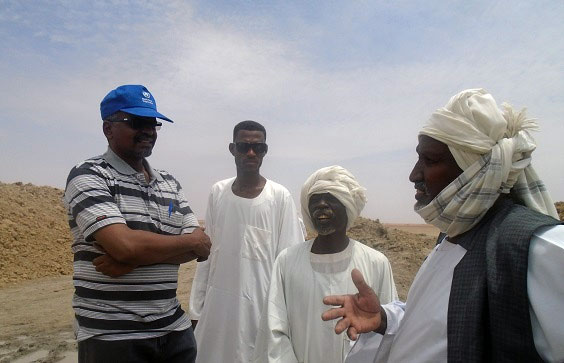 Khalid Sarour speaking with community leaders in White Nile state (Photo: Khalid Sarour/WHO Sudan).
Khalid Sarour speaking with community leaders in White Nile state (Photo: Khalid Sarour/WHO Sudan).
The main cause of infection in White Nile, says Khalid Sarour (43) of the World Health Organization, is the lack of safe water. “Most people use the Nile’s river water for all of their daily needs. Bathing, going to the bathroom, but also drinking and cooking. They often do not know, or are unable, to filter, chlorinate, or boil all their water before they use it.” Additionally, bacteria can grow easily in the sometimes stagnated water in the White Nile. Water levels alternate from quite low to flooding, and the surrounding air temperatures are high.
The amount of cars and trucks that come through White Nile are another factor in the high amount of cases in the state. Khalid: “Sitting in this restaurant for an hour, you will see tens of trucks, sometimes hundreds, coming from all over Sudan.” If drivers, passengers, or their cargo carries bacteria that cause AWD, these can spread and infect more people. Perhaps no surprise then, that a quarter of all Sudanese AWD cases since the start of the outbreak have been found in White Nile, followed at a distance by Sennar with 3,744 patients.
Additionally, conditions are generally favorable for bacteria growth in the White Nile water when the water flow is quite low, and during high temperatures. Due to flooding, the contamination of scarce water sources, high population density, and migration makes the state vulnerable to outbreaks.
Where nurses like Somaia have been saving lives on a daily basis since the beginning of the outbreak, WHO staff like Khalid have worked tirelessly behind the scenes in close collaboration with Sudan’s Health Ministry and other health partners. With generous support from for example the Sudan Humanitarian Fund, the men and women in WHO’s blue T-shirts work side by side with their Ministry of Health counterparts on early warning of new cases, rapid response to those cases, and strengthening of the health systems and sector nationwide.
As environmental health officer, Khalid himself works closely with White Nile State’s Health Ministry on issues of water safety, vector control, and hygiene promotion. All these prevention, early detection, response, and health system building activities have not been without success: the death rate in White Nile is one of the lowest in Sudan, despite the high number of cases. In total, out of 8,824 cases, 8,712 people (98.7%) were saved.



